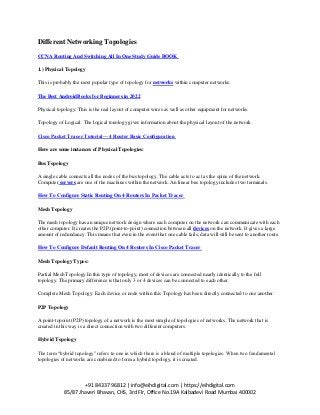
Different Networking Topologies.pdf
- 1. +91 84337 96812 | info@eihdigital.com | https://eihdigital.com 85/87 Jhaveri Bhavan, CHS, 3rd Flr, Office No.19A Kalbadevi Road Mumbai 400002 Different Networking Topologies CCNA Routing And Switching All In One Study Guide BOOK 1.) Physical Topology This is probably the most popular type of topology for networks within computer networks. The Best AndroidBooks for Beginners in 2022 Physical topology: This is the real layout of computer wires as well as other equipment for networks. Topology of Logical: The logical tonology gives information about the physical layout of the network. Cisco Packet Tracer Tutorial — 4 Router Basic Configuration Here are some instances of Physical Topologies: Bus Topology A single cable connects all the nodes of the bus topology. The cable acts to act as the spine of the network. Computer servers are one of the machines within the network. An linear bus topology includes two terminals. How To Configure Static Routing On 4 Routers In Packet Tracer Mesh Topology The mesh topology has an unique network design where each computer on the network can communicate with each other computer. It creates the P2P (point-to-point) connection between all devices on the network. It gives a large amount of redundancy. This means that even in the event that one cable fails, data will still be sent to another route. How To Configure Default Routing On 4 Routers In Cisco Packet Tracer Mesh Topology Types: Partial Mesh Topology In this type of topology, most of devices are connected nearly identically to the full topology. The primary difference is that only 3 or 4 devices can be connected to each other. Complete Mesh Topology: Each device or node within this Topology has been directly connected to one another. P2P Topology A point-topoint (P2P) topology of a network is the most simple of topologies of networks. The network that is created in this way is a direct connection with two different computers. Hybrid Topology The term “hybrid topology” refers to one in which there is a blend of multiple topologies. When two fundamental topologies of networks are combined to form a hybrid topology, it is created.
- 2. +91 84337 96812 | info@eihdigital.com | https://eihdigital.com 85/87 Jhaveri Bhavan, CHS, 3rd Flr, Office No.19A Kalbadevi Road Mumbai 400002 Tree Topology Tree topologies have one root node which joins all the other nodes to form an order. It is the reason they are sometimes called a the hierarchical topology. This type of topology is called the Star Bus topology because it blends several star topologies into one bus. The Tree topology is a common network design that is similar to star and bus topologies. Ring Topology Each device within the ring network is connected to two other devices nearby to communicate. It is referred to as an ring topology since it’s design resembles that of the appearance of a rings. Each computer in this topology is connected to another. The last node is joined with the initial one, in this instance. In order to transfer information between computers the system uses tokens. In this system the messages are sent through the same manner through rings. Star Topology All computers within this topology connected via the hub. The hub is known as a central hub, and it is the one that connects all other nodes. It is the most frequently used in LAN networks due to it being inexpensive and easy to establish.